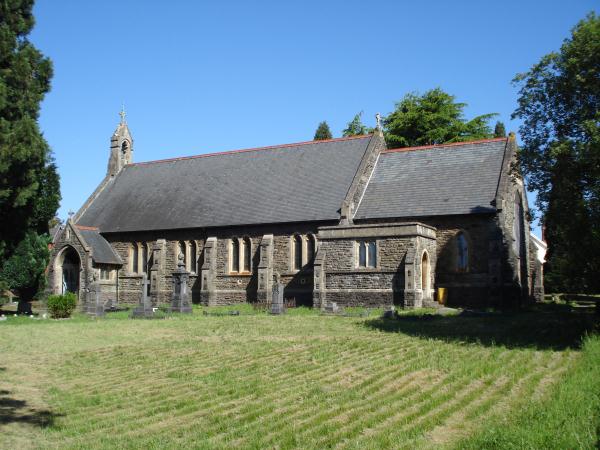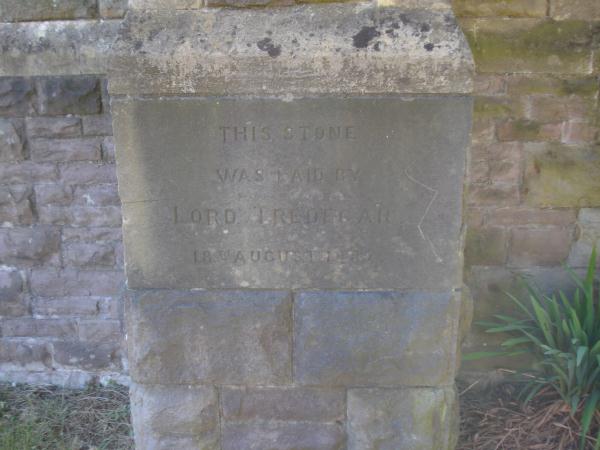CONTENTS
1. INFORMATION
2. WHY THE NAME
2.1 INTROUCTION
2.2 A BRIEF HISTORY
2.3 THE BUILDING
3. COMPLETING THE CACHE
4. CHURCH MICRO SERIES
5. REFERENCES
1. INFORMATION
This is our sixth cache in Rogerstone and, like the others, it
follows a simple theme – places in Rogerstone. The caches can
be completed together to make a circular walk around Rogerstone.
The reason for the name of the cache, Rogerstone Saint John the
Baptist (Church Micro 1217), is explained below.
The above co-ordinates are not those of the cache. They are the
co-ordinates of the entrance to the churchyard. The terrain rating
reflects the narrowness, in places, of the paths and the fact that
there is a need to cross grass.
The cache is a short multi that takes you to a small clip lock
box in a camouflage bag located within the churchyard of Saint John
the Baptist, Rogerstone. Permission for this cache had been granted
by the vicar. There is no time limit associated with the
permission. However, the permission can be withdrawn at any time
should problems occur. It is requested that due regard is made for
others in and around the churchyard (considerate car parking,
etc).
When we set it up we had a good GPS signal at the cache location
so the final co-ordinates should be as accurate as possible.
However, should you have any problems please use the Additional
Hint.
As before any comments (are our estimates of the Overall
Difficulty and Terrain ratings correct?) about the cache will be
greatly received.
Also, this our first attempt at using HTML. We hope that it
improves the presentation of this cache description. Please forgive
any oddities in the layout.
2. WHY THE NAME
2.1 INTROUCTION
This time the cache name, Rogerstone Saint John the Baptist
(Church Micro 1217), is obvious so we will give a history of the
Church.

St. John the Baptist Church
Rogerstone
The church of Saint John the Baptist, Rogerstone, is part of the
Rectorial Benefice of Bassaleg. The Benefice is situated just to
the west of Newport in South East Wales. It has three Churches:
Saint Basil's in Bassaleg; Saint Anne's in High Cross and Saint
John the Baptist in Rogerstone. It is part of the Diocese of
Monmouth in the Church in Wales, which is part of the worldwide
Anglican Church.
It is interesting to note that, until 1920 and the
disestablishment of the Church in Wales, the Parish of Bassaleg was
in the Diocese of Llandaff and part of the Church of England. In
September 1921 the Diocese of Monmouth was created by the Church in
Wales, with the Right Reverend C.A.H. Green as its first bishop,
and the Parish of Bassaleg became part of that Diocese, where it
remains today.
2.2 A BRIEF HISTORY
The coming of Nettlefords and their Shropshire workforce was the
instigation for new churches to be built in Rogerstone. Lord
Tredegar gave the land for the building of a Church for the
Anglicans at the top of the village.
At the west end of the church is a stone bearing the
inscription:
”This stone
was laid by
Lord Tredegar
18th August 1887”

Foundation stone
It was laid by the second Lord Tredegar, Godfrey Morgan; later
to become Viscount Tredegar. The parish owes much to the generosity
of the Tredegar family, not least because of the gift of both
Church and church hall in Rogerstone.
The building of the Church began in August 1887 and was
completed, probably in the summer, of 1888 at a cost of £2 370.
When built the Church was equipped with a baptistery, as baptism by
total immersion was a feature of local life at that time.
The Bishop of Llandaff consecrated the church, with its title
and dedication being in honour of Saint John the Baptist. The
village of Rogerstone was provided with a fine church and the local
people no longer had to walk to the parish church in Bassaleg for
worship.
The church hall (used as a Sunday school and parish room) was
later added close to the church and opened in 1900.
2.3 THE BUILDING
The interior of the church building has an 'open' feel. The
wooden pews are the original ones and can seat around 300. The font
is near the main entrance at the rear and set into the floor
nearby, and normally covered, is a baptising pool used for the
immersion of older children and adults during their baptisms.
The window above the altar depicts the risen Christ outside the
tomb on Easter morning, speaking to Mary of Magdala, with two
angels looking on. To either side of the altar, the windows show
Jesus as the 'Light of the World' and 'the Good Shepherd'.
3. COMPLETING THE CACHE
To complete this cache you need to locate two memorial stones
within the churchyard and record some numbers. You can do this
either by locating the memorial stones or by Internet research.
Part 1: Locate the memorial stone dedicated to Vivian Lawrence
Roberts. Vivian Lawrence Roberts, who held the rank of Volunteer in
the Home Guard (unit: 13th Gloucestershire (City of Bristol) Bn),
died on the 25th September 1940. Record his age (two digits
AB).
Part 2: Locate the memorial stone dedicated to Amy Brown. Amy
Brown, a sister in the Queen Alexandra's Imperial Military Nursing
Service was lost at sea on the 12th February 1944. Record her age
(two digits CD).
In Saint John the Baptist’s Churchyard Amy Brown is
remembered on the grave of her aunt and uncle. However, as Amy
Brown has no known grave her name is formally listed on the
Brookwood Memorial.
The Brookwood Memorial, in Surrey, commemorates nearly 3,500 men
and women of the land forces of the Commonwealth who died during
the Second World War and have no known grave, the circumstances of
their death being such that they could not appropriately be
commemorated on any of the campaign memorials in the various
theatres of war. They died in the campaign in Norway in 1940, or in
the various raids on enemy occupied territory in Europe such as
Dieppe and St Nazaire. Others were special agents who died as
prisoners or while working with Allied underground movements. Some
died at sea, in hospital ships and troop transports, in waters not
associated with the major campaigns, and a few were killed in
flying accidents or in aerial combat.
The cache is located at:
N 51° 35.4(5+A)(4-B) W 003° 03.5(1+C)(4+D)
As young people often loiter around on the steps in the corner
behind the church you need to be careful when looking for and
replacing the cache.
4. CHURCH MICRO SERIES
The numbering of the church micro series of caches is managed by
‘sadexploration’. If you would like to expand to this
series please do so. But please you could let
‘sadexploration’ know (via his Profile) so he can keep
track of the church numbers and names to avoid duplication.
5. REFERENCES
Note, the sources of the historical information are: -
‘Images of Wales – Rogerstone’, by Kim Fry,
published by Tempus and available from Rogerstone Library.
The Rectorial Benefice of Bassaleg web site
http://www.bassalegbenefice.org/index.htm